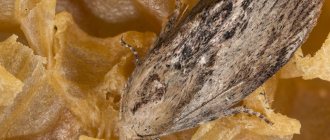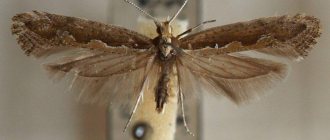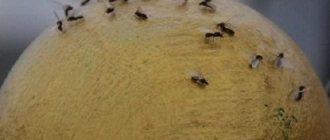In nature, there are several types of domestic moths: grain moths, furniture moths, clothes moths and fur moths. All these insects are capable of causing some damage to products and things. Many are familiar with the classic moth, which lives in closets and feeds on items made of fur and natural fabric. This is a small clay-yellow butterfly, from whose eggs many tiny moth larvae emerge. They are the ones who have a good appetite and pose a danger to things. Protecting fur coats, woolen products and food from moths is the task of every caring housewife. There are different methods of pest control, but the safest are folk remedies for moths. Our article will tell you how to get rid of moths using folk remedies.
Citrus peels
Orange or lemon peels are a traditional folk remedy against moths. Their strong smell is not to the liking of adults. Therefore, in every section of the cabinet where orange peels are laid out, butterflies will not dare to lay eggs. Tangerine peels have a similar effect.
Citrus peels
To obtain the desired effect, the peel of a tangerine or orange must be fresh; it is important to prevent it from drying out or developing mold. Since dry citrus peels do not have a strong aroma, they will not protect against pests. Therefore, they need to be changed regularly.
Important! You can use tangerine or orange peels only for preventive purposes, since they are not capable of getting rid of moth larvae that have already settled in a fur coat.
horse chestnut
It turns out that chestnut protects well from insect pests. Its seeds should be collected in late autumn.
After drying them in the oven (raw chestnuts quickly become moldy), place them on shelves in the cupboards. You won't need bags here.
Chestnut has several advantages:
- The fruits are easy to collect and just as easy to arrange;
- They act effectively and do not have a strong aroma ;
- The fruits are quite large in size, so they are not capable of littering the apartment.
Cloves, thyme, rosemary
Cloves, thyme and rosemary
Having placed bags of thyme, rosemary and cloves around the apartment, you will not know what moths are for several months. The fact is that the insect cannot tolerate the spicy smell of these plants. Therefore, in order to get rid of pests forever, it is necessary to replace old aromatic sets with fresh ones from time to time.
Review
My wife is allergic to many insecticides, so we used traditional methods to fight moths. And after its destruction, bags of cloves were placed in cabinets. And the smell is pleasant, and moths do not bother me.
Oleg, Perm
What else is a moth afraid of?
In the housewife's attempts to find what the moth is afraid of (folk remedies), she may find the following recommendations for use:
- indoor plants with a strong odor;
- spicy medicinal plants;
- some fruits;
- essential oils;
- synthetic drugs in the form of suspended elements.
When fighting flying pests in an apartment, you should remember that it is not the butterfly that spoils food and things, but its larvae, deposited in secluded places deprived of access to fresh air. You will have to get rid of them yourself or using chemicals.
A variety of folk remedies only repel such insects. If there are already too many of them, you may need to resort to chemical insecticides. The larvae die from them and this guarantees complete disposal of the pest once and for all.
Essential oils
Essential oils are an excellent and very effective folk remedy for repelling moths. In addition to the eucalyptus composition, lavender, fir, clove, lemon and rosemary oils are widely used. Insects do not like their fragrant aroma.
Using essential oils for moths is not difficult at all. It is enough to add a few drops of any oil to a container of water and wipe the shelves in the closets, floors, kitchen surfaces and furniture in the room with it. You can also spray the surface of upholstered furniture with this solution.
Important! To enhance the effect, cotton swabs soaked in oil will help, which should be placed in each room.
How to use?
Both dried lavender twigs or flowers and its essential oil (often used in many industrial products aimed at getting rid of pests) will equally help to get rid of harmful insects.
Dried
If the herbaceous plant is grown in the garden or grows nearby, then it should be cut and dried in the summer (it is better to start collecting 2 weeks after the start of flowering - then the crop will have the most intense aroma).
You can dry lavender both in the apartment (for example, on the balcony) and on the street. To do this, a fresh bouquet needs to be divided into several bunches , tied and hung to dry.
If you don’t want to make the preparations yourself, you can purchase already dried grass.
When the plant is prepared, it can be made into a fragrant sachet, which is then placed :
- in closets with clothes;
- in chests of drawers;
- in dressing rooms;
- in chests, etc.
Lavender bags can be placed on shelves between piles of clothes and hung in different places in the closet.
To make such a fragrant product, you will need:
- two square pieces of fabric, with a side of 10 cm;
- threads, needle and scissors;
- crushed dried lavender.
Now you should sew two pieces of fabric together (from the wrong side), leaving a small hole - through it you will need to lay the dried grass. Now the hole should be sewn up and the fragrant sachet is ready.
There is an easier way to make a lavender bag. To do this, you will need a small square piece of fabric, in the center of which the dried crop is laid out. Then the 4 corners are gathered in the center and tied with ribbon, rope or thread. You can also place the grass in special porous bags.
The validity period of such products is approximately 2 months . After this time, they cease to be fragrant and therefore require replacement.
You don't have to make sachet - you can just hang bunches of dried lavender in your closets. For a longer lasting effect, other strong-smelling herbs can be added to this crop. But in this case, it is necessary to ensure that the inflorescences do not fall off onto clothes or bedding.
To repel moths, you can place fragrant, dry bouquets of lavender in all rooms - they will not only prevent the appearance of insects, but will also become an excellent interior decoration. In addition, this herbaceous plant is safe for both humans and pets.
You should choose strong-smelling branches, otherwise there will be no guaranteed effect from using the crop.
In the form of essential oil
Essential oil is no less effective in fighting moths.
The easiest way to use it is to place open vessels directly on the cabinet shelves. To protect clothes, you can spray them with a decoction of lavender flowers, which is prepared as follows:
- Place 1 tablespoon of lavender inflorescences in a container.
- 400 ml of boiling water is poured.
- Close the lid tightly (so that the essential oil does not evaporate) and leave for 10-15 minutes.
You should not spray clothes with pure ether, because if it contains an additive in the form of palm or sunflower oil, noticeable stains will remain on things that cannot be removed.
A proven method used to combat moths for several centuries is the production of sachets. It's very easy to make it yourself. For this you will need :
- linen fabric (for one product you will need a square with sides of 10 cm);
- lavender oil;
- odorless edible sea salt (or woolen threads);
- ribbon or thread and needle.
To make a sachet you need:
- Place salt or threads in the middle of the fabric.
- Sprinkle with lavender oil (7-10 drops are enough).
- Sew the fabric along the edges to create a pillow or connect its ends, tying tightly with ribbon.
The fragrant sachet is ready. It is laid out on shelves in closets, dressing rooms, chests of drawers with bed linen.
You don't have to use only lavender oil to repel moths. You can add a couple of drops of citrus essential oil or rose, geranium, pine, and mint oil.
Another effective way to combat harmful insects is to use a spray with lavender essential oil. To do this you will need :
Combine lavender ether (10 drops) with ethyl alcohol (10 ml).- Pour the solution into a container with a spray bottle.
- Spray linen drawers and cabinet shelves with the resulting spray.
Lavender oil can be added to water when washing floors or wiped furniture with such fragrant water. Thanks to this, the pleasant smell of lavender will reign in the room for a long time, which will protect the house from moth invasion.
Naphthalene
Naphthalene is truly a folk remedy. Its effect in the fight against moths has been known since the time of our grandmothers. However, the latest research has proven that the drug contains carcinogenic substances that are unsafe for human health. Therefore, naphthalene was not used to kill food moths, since the products are capable of absorbing odors.
They began to use naphthalene against moths only in closets, laying it out on shelves, in bags with woolen items, in the pockets of coats and fur coats.
Mint
Like lavender, this plant has a strong scent .
It is used in a similar way: the dried leaves are laid out in small bags and placed where there should be a large concentration of pests.
From time to time it is recommended to check whether the pouch is exhausted. If this happens, replace it with another one with fresher dried leaves. To increase efficiency, you can place them in the wardrobe in the pockets of sweaters, coats, fur coats and jackets .
Laundry soap
An excellent folk remedy for moths in the closet is laundry soap. Both clothes and kitchen moths are afraid of its smell. The principle of use is quite simple: you need to place bars of scented soap in the closet between things or products. You can also treat all interior surfaces of furniture cabinets with soapy water.
Review
“To get rid of moths, I used laundry soap on the advice of my mother and reviews from a friend. I treated both the closet, which was favored by insects, and other places where clothes were stored for prevention. Afterwards I left small pieces of soap in the cabinets. Moths don’t bother me anymore!”
Inna, Ryazan
Fragrant tobacco
Tobacco is another effective folk method against gray butterflies. Fragrant tobacco is usually used as a houseplant, but as for smoking tobacco, it is better to use it in the form of small dry leaves, as in the cigarettes we are used to.
Place regular tobacco in bags and place inside pieces of furniture. Don't forget to ventilate your wardrobe periodically.
Attention! Do not use tobacco to protect clothing from moths. Things soaked in it will lose their attractiveness.
Other folk methods
Other folk remedies can also help in the fight against moths.
- Moths cannot stand the smell of cedar. By placing its branches and pieces of wood in your wardrobe, you will save your fur coat from moths. For the same purpose, you can use a folk remedy such as cedar oil.
- There will be no insects in the cabinets if you place tampons soaked in camphor in them.
- Black pepper is another folk remedy for controlling household pests. It’s enough to put bags of peas on the shelves, and no one will get into your things.
Black pepper, oil and cedar bark
Review
Irina, Moscow: “Traditional methods did not help in the fight against moths. Perhaps the reason is that there was a lot of it. We had to use chemicals."
Irina, Moscow
How to get rid of moths
Among all types of moths, house pests usually include clothes moths (also known as house moths) and food moths. Both of these species feel comfortable around humans. But in some ways they differ.
The main difference between clothes moths and food moths is their diet. The first eats wardrobe items, the second prefers grains, cereals, even pasta and other groceries.
- Beach moth
The adult clothes moth is a butterfly-like insect that is pale beige in color. Upon closer inspection, you can also notice a “fluffy” body between the wings. The adult is about 5–8 mm long and has a wingspan of 9–16 mm. Clothes moths usually simply fly into a home through an open window.
House moths have shiny wings
- food moth
The food moth has the same size, but a slightly different color. It can be from grayish-straw to the color of butter. Some individuals are even distinctly yellow. In addition, her body is not “fluffy”. The food moth practically does not fly - its wings are poorly developed. How does she get into the house? Usually moth eggs enter the apartment along with dried fruits or cereals.
Moth eggs of both species are light beige, almost white cylinders ranging from 0.4 to 0.5 mm in length. On one side they are slightly more pointed than on the other.
Moths usually lay eggs in places where the caterpillars will immediately find food - in wardrobes, food
Few people know, but in fact, it is not the adult flying individual (usually a male, by the way) that causes damage to your things, but the caterpillars. Therefore, in the fight against a pest, it is not enough to eliminate those insects that fly around the rooms - you need to destroy the eggs and hatched larvae.
Benefits of folk remedies against moths
Many housewives give preference to folk remedies for protection against moths, resorting to radical methods of control only in extreme cases. And this is correct, since folk remedies do not contain harmful substances, therefore they are safe for human health. This is especially true for families with small children.
The advantages of folk remedies for moth control also include their availability and low cost, which is an important factor in modern life.
Do not forget that folk remedies for fighting moths are best used for preventive purposes. The most optimal option for using them, as well as special sections against moths, is before a winged pest appears in the house. If there is a large concentration of pests, complex treatment using insecticidal preparations for moths such as Antimol is necessary.
Geranium
The fight against small gray butterflies that have settled in the house is not always active and involves the use of means specially prepared for this. There are also passive ways. Often it is enough to place an indoor flower on the windowsill, like an ordinary geranium .
Many insects cannot tolerate the smell of this plant. If the apartment is large, get several bushes. Place one pot in each room. Geranium is equally effective against both kitchen and clothes moths.
Always keep live flower bushes in your apartment. Periodically open kitchen cabinets, wardrobes and bedside tables, ventilating them once every few days.
Adviсe
- At the end of the cold season, before storing a fur coat or hat, they must be cleaned and dried well.
- To store fur and wool products, it is better to use special cases in which dried herbs or oil-soaked tampons should be placed.
- You should regularly audit your wardrobe. Any insect will feel at ease where it is not disturbed. Therefore, regular inspection and cleaning of cabinets will help prevent the appearance of moths. Each fur or wool product must be carefully inspected for the presence of moth larvae.
- Fur items should be shaken regularly to prevent damage. After all, the larvae and eggs of insects adhere to them very weakly, and fall off at the slightest shaking. Therefore, during wearing, things are not exposed to insects. Those that sit on the shelf for a long time suffer more.
- Warm blankets, blankets, pillows and carpets must be periodically taken out into the fresh air to dry.
- If traces of pest activity are detected, all items in the closet should be heat treated against moths. In winter, they can be laid out in the cold or hung in direct sunlight in summer. Items that are subject to hot processing must be washed and ironed. When washing clothes, you can add a few drops of essential oil and vinegar to the water. Folk or chemical anti-moth remedies will not be superfluous.
- To prevent moths from infesting winter boots or boots, they must be dried before storing them. You can put any anti-moth remedy inside (a sprig of tansy or lavender, a tampon soaked in essential oil, or tobacco).
- To prevent kitchen moths from infesting the house, all bulk products brought home must be stored in glass jars or tightly closed containers.
- Regular cleaning and ventilation of the premises are the key to a clean, pest-free home.
Knowledge of folk remedies and the rules for their use will help prevent the appearance of moths in your apartment.
Where do moths live?
Clothes moths reveal themselves by the appearance of small through holes in textiles. She has good taste - she prefers natural fabrics like wool, cashmere, silk. Signs of food moths are even less pleasant - you will find tiny moth eggs or even hatched larvae in flour, grains, cereals and other products that are not stored in the refrigerator.
Secondary signs of moths appearing in an apartment are various cobwebs, short white fluff, and lumps of unknown origin. They remain after the pupa transforms into a moth. But still, the main sign that we will focus on is moth eggs.
An adult moth does not lay eggs just anywhere - it creates specific nests. Their walls usually consist, like those of birds, of any “available materials”: villi, scales, dust, even the feces of the insects themselves. It is not difficult to identify the nest - it is a light “clump”, as if molded from softened oatmeal. In size it usually does not exceed 2–3 cm in diameter.
Once you find the nest, you can immediately destroy the main threat
Where should such nests be looked for? Clothes moths usually create nests in the folds of some clothing made from natural fabric. She doesn’t disdain upholstery either. Small nests can even be found in the seams of textiles. Food moths choose other places - namely bags with flour, cereals, dried fruits. The nest may also be in a hermetically sealed jar - perhaps the purchased products have already been infected with eggs.
If you find a moth nest, you must dispose of it immediately. Wearing gloves, place the item that the moth has chosen in a plastic bag and wrap it tightly. Dispose of the nest in the yard without delay - no need to put the nest in your own trash can.
If a moth has chosen a piece of clothing that is very dear to you as a nesting site, then you can save it. Scoop the nest from the clothing into a bag. Be careful not to leave any eggs on it. Then take the damaged item to the dry cleaner.
Scented herbs
Insects are repelled by bunches of wild or cultivated fragrant herbs. Among them, the most effective means are the following:
- Sagebrush;
- Tansy;
- Chamomile;
- Valerian;
- Marigold;
- Carnation.
Other folk methods and means to repel annoying pests:
- Camphor . Soak swabs in it and place them in places where butterflies accumulate.
- A combination of lemon and cloves . The buds of a spicy plant are stuck into half a lemon and suspended on a strong thread above the shelves with things.
- Pieces of cedar twigs and wood are also not carried by insects. Place them in wardrobes where fur coats hang. You can also use cedar needle oil for this purpose.
- black pepper (peas) using the same method .
- Residents claim that sometimes gray butterflies are repelled by the smell of fresh newspapers . But experts consider this method rather dubious.
Advice! To prevent insects from infesting the kitchen, the best solution would be to store cereals in closed containers or tightly tied bags. Before storage, clean outer clothing and put plastic covers on it.
Do not forget to regularly ventilate the apartment and constantly clean it using disinfectants. Moths are afraid of low and high temperatures. So washing in hot water, frying clothes in the open sun or airing in frosty air makes it possible to get rid of females, eggs of pests or their larvae.
By the way, the larvae and eggs are attached to clothes very weakly, so they fall to the floor at the slightest shaking. For this reason, items that are constantly worn are rarely damaged. Those who hang in wardrobes for a long time and wait in the wings suffer the most.
A few facts about moths
To date, insectologists have described several dozen varieties of this voracious small butterfly. Among the representatives of this family, in addition to the well-known clothes moth, there is a very large group of insects that prefer to eat food rather than wool, and their menu can be very diverse - from cereals and fruits to nightshade leaves, which are the favorite delicacy of the potato moth .
It would be naive to believe that moths, having no teeth or digestive system at all, can gnaw passages in the thickness of carpets, eat coat collars or make holes in the pages of tomes, as the book moth allegedly does. Of course, the small whitish butterfly itself is completely harmless, but it lays eggs, from which translucent tiny caterpillars hatch, with an insatiable appetite and superbly developed mouthparts. Here they are, these same worms, and tirelessly gnaw everything that comes their way.
Chasing moths fluttering around the house is a pointless activity. As a rule, almost all moths flying in apartments are males, so there is very little benefit from killing fluttering butterflies. Females are more careful - they travel around the home in “short dashes”, and in between flights they hide in the folds of curtains and clothes, where they lay eggs, from which harmful caterpillars then emerge.
Precautionary measures
In an attempt to get rid of uninvited guests, housewives often resort to a remedy such as vinegar. To do this, pour vinegar into a hot frying pan and add a few drops of essential oils. The smell coming from the fumes is unbearable for moths.
And if you wipe the places where the eggs are deposited with vinegar, then all the larvae will die. The method is very effective. Just don’t neglect safety precautions.
People with allergic reactions or intolerance to any substances should approach the choice of any means for the destruction and prevention of moths with caution.











